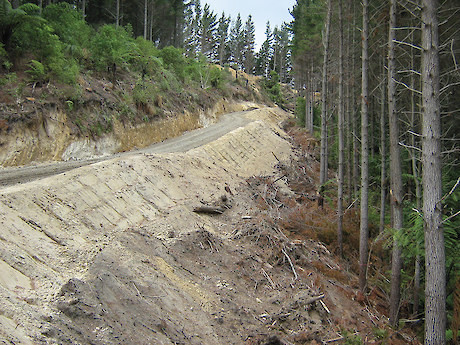This chapter outlines road construction techniques and practices, and provides information on machinery types, machinery combinations, and the situations for which they are best suited.
 Well-constructed road with good salvage width and construction techniquesWell-constructed roads require both teamwork and coordination as the project goes through the planning, layout and construction phases. Roading planners need to talk to engineers, roading and harvesting supervisors, and contractors. Supervisors and contractors need to voice operational concerns. On steep, erosion prone hill country, earthworks need to be carefully managed. A skilled, efficient and resourceful team will identify and address potential issues before they arise.
Well-constructed road with good salvage width and construction techniquesWell-constructed roads require both teamwork and coordination as the project goes through the planning, layout and construction phases. Roading planners need to talk to engineers, roading and harvesting supervisors, and contractors. Supervisors and contractors need to voice operational concerns. On steep, erosion prone hill country, earthworks need to be carefully managed. A skilled, efficient and resourceful team will identify and address potential issues before they arise.
For river crossings and water control measures including debris traps, see Chapters 6 and 7. For general information on traffic and hazard management, and road signage refer to WorkSafe’s Approved Code of Practice for Safety and Health in Forest Operations (ACOP). Where the ACOP specifically details road construction requirements these have been included in this Manual.
The diagram below describes some of the commonly used roading terms.
Common roading terms Figure showing common roading terms used for forest road construction
Figure showing common roading terms used for forest road construction